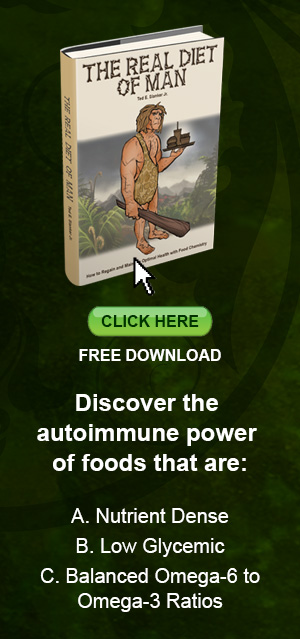Low PUFA Diet
Column #344 April 8, 2022
Many folks don’t know the lingo when it comes to discussing fats. So what does PUFA mean? It stands for polyunsaturated fatty acids. These fats are fluid at room temperatures while saturated fats are hard.1
There are numerous articles out there about PUFAs. According to the American Heart Association’s website PUFAs keep you healthy while saturated fats kill you. Then there are other sites that say PUFAs are bad for you and for proper health you need saturated fats. Both are partially wrong.2
PUFAs include the Omega-6 and Omega-3 families of fatty acids. We say families because there are several Omega-6 fats as well as Omega-3 fats. Of less importance are Omega-9 fatty acids which are also PUFAs. Of all the hundreds of fatty acids, the only essential fatty acids (EFAs) are the Omega-6 and Omega-3 EFAs. All “essential” nutrients must be eaten or absorbed for the body to have them. And, without all of the essential nutrients, poor health and death will result. All nonessential nutrients the body needs are synthesized by the body.3 4 5
Let’s deal first with the myths put out by the American Heart Association. It states point blank that “Saturated fats are found in animal-based foods like beef, pork, poultry, full-fat dairy products and eggs and tropical oils like coconut, and palm. Because they are typically solid at room temperature, they are sometimes called ‘solid fats.’ Saturated fats can cause problems with your cholesterol levels, which can increase your risk of heart disease. Replacing foods that are high in saturated fat with healthier options can lower risk of heart disease.”
The last two sentences of that quote are pure bunk. Quite a few years ago the 150-year-old theories about saturated fats causing heart disease were finally tested and debunked. The paper titled “Saturated Fat Is Not the Major Issue” by Aseem Malhotra explains why. He is a famous heart specialist.6
On the other side of the aisle are folks saying that a diet without PUFAs is best! Then they go about explaining why all PUFAs will oxidize and that’s bad for you. Ironically, to use fats as fuel they must be oxidized. Here’s how one site presented it: “PUFAs are highly unstable fats. Fats have a certain temperature that causes them to oxidize. The oxidation of fats means they can become unstable, become toxic, go rancid, etc. The oxidation temperature for PUFAs is very low. Oxidation leads to free radicals. Free radicals lead to cellular damage in your body that can manifest both internally in the form of damaged organs/glands and externally in the form of rapidly aging skin. Moreover, perhaps the scariest thing about oxidized fats is that they are inflammatory.”7
Wow, if we totally eliminate PUFAs that would eliminate the essential fats! But wouldn’t that be certain death in a relatively short period of time? Yes, it would. So what’s going on here? Where’s the villain in the PUFAs? Vegetable oils are PUFAs, so why is that bad? Their problem is that most of them are loaded with Omega-6 EFAs with very little Omega-3 EFAs. There’s no doubt these oils are very bad for your health since some of the Omega-6 EFAs have been proven to be very inflammatory.
In spite of the evidence, the American Heart Association says its recommended list of cooking oils contain more of the “better-for-you” fats and less saturated fat. It promotes using Canola, Corn, Olive, Peanut, Safflower, Soybean, and Sunflower oils. “Blends or combinations of these oils, often sold under the name ‘vegetable oil,’ and cooking sprays made from these oils are also good choices. Some specialty oils, like avocado, grapeseed, rice bran and sesame, can be healthy choices but may cost a bit more or be harder to find. In general, choose oils with less than four grams of saturated fat per tablespoon, and no partially hydrogenated oils or trans fats.”8
Yep, the oils recommended by the American Heart Association are loaded with Omega-6 EFAs and that’s THE problem. Why that organization promotes them is beyond me. It’s been known for decades that for optimal health there’s a specific ratio that must exist between Omega-6 and Omega-3 EFAs in the membranes of our cells. That ratio is close to 1:1 (one to one) by weight.9
There are quite a few essential nutrients that need to be in a certain ratio with other nutrients. If not, poor health is the result. In the past 50 plus years, more than 20,000 studies involving the Omega-3 EFAs have been published. They conclude that when the ratio of Omega-6 to Omega-3 EFAs in a human exceeds 4:1, the incidence rate for chronic diseases starts increasing dramatically. In 2008, Dr. Artemis Simopoulos stated that the EFA ratio for the average American was 16.7:1. (It may be worse today.) What this means is that if Americans want to be healthier, they must dramatically either reduce their Omega-6 intake or make a huge increase in their Omega-3 intake. It does not mean they should eliminate all PUFAs.10
Grass-fed meats have EFA ratios that center around 1:1. They also contain every nutrient known for what is considered to be a perfect nutritional balance for a human. So, if a person eats nothing but grass-fed meats they will have a low PUFA diet and a perfect balance of nutrients for optimal health. Unfortunately, very few people are strict grass-fed carnivores. I’m a good example.
For breakfast I like two small grass-fed beef patties (⅓ pound total), a piece or two of grass-fed beef bacon, and two eggs that advertise 140 mg of Omega-3. The two beef paddies provide about 100 mg of Omega-6 and 100 mg of Omega 3. The beef bacon provides about 40 mg of Omega-6 and 40 mg of Omega-3. But the eggs have 660 mg each of Omega-6 for a total of 1,320 mg of Omega-6 versus a total of only 280 mg of Omega-3. Because of the eggs, my breakfast’s EFA ratio is 3.5:1 with an Omega-3 deficit of 1,040 mg. If I aim for a 1:1 ratio, I need to boost the Omega-3 by taking two-thirds of a teaspoon of fish oil.11
You can see, it doesn’t take much deviation from eating only grass-fed meat to require an Omega-3 supplement. This is why if you want optimal health, you need to deliberately avoid foods loaded with Omega-6. Twenty-six macadamia nuts weigh four ounces. They have 1,478 mg of Omega-6 and only 222 mg of Omega-3 for a deficit of 1,256 mg of Omega-3. When it comes to nuts, macadamia nuts have the smallest Omega-3 deficit. For instance four ounces of dry roasted pecans are so loaded with Omega-6 that when consumed they create a 21,074 mg DEFICIT of Omega-3. To compensate for that huge Omega-3 deficit, one needs to take FIVE tablespoons of fish oil. Processed foods, foods cooked in vegetable oils, grains, nuts, seeds, some fruits such as avocados and olives, and conventionally raised meats are loaded with Omega-6 EFAs.12
So, unless we eat nothing but grass-fed/Omega-3 meats, wild caught seafood, green leafy vegetables, beans, and squashes, we will not have a “perfectly low PUFA diet.” If we venture out and eat just a little of what other people eat, we must supplement with Omega-3—which is a PUFA. After supplementation, if our EFA ratio is real close to 1:1, we will still be healthy even though the PUFA quantity will be rather high. Yet even so, we should strive to get our 1:1 EFA balance naturally from whole foods. There’s no practical way to eat the Standard American Diet (SAD) and correct its Omega-3 deficit. That would require a lot of fish oil and make for an extremely high PUFA diet.
In order to Nix6 and Eat3, use our food tables for assessing your whole food selections. I also highly recommend that everyone test their EFA ratio by getting a self-test from “Omega-3 Test.” If you put slanker in the offer code, the test costs about $100.13 14
To your health.
Ted Slanker
Ted Slanker has been reporting on the fundamentals of nutritional research in publications, television and radio appearances, and at conferences since 1999. He condenses complex studies into the basics required for health and well-being. His eBook, The Real Diet of Man, is available online.
Don't miss these links for additional reading:
1. Polyunsaturated Fatty Acid from Wikipedia
2. Saturated Fat by American Heart Association
3. Omega-9 Fatty Acid from Wikipedia
4. Omega-6 Fatty Acid from Wikipedia
5. Omega-3 Fatty Acid from Wikipedia
6. Saturated Fat Is Not the Major Issue by Aseem Malhotra
7. PUFAs: What They Are & Why You Should Ditch Them by Katie from Integrum Living
8. Healthy Cooking Oils by American Heart Association
9. The Importance of the Ratio of Omega-6/Omega-3 Essential Fatty Acids by A.P. Simopoulos
10. The Importance of the Omega-6/Omega-3 Fatty Acid Ratio in Cardiovascular and Chronic Diseases by A.P. Simopoulos
11. Ted Slanker’s Omega-3 Blood Test
12. Food Analysis: EFA, Protein to Fat, Net Carbs, Sugar, and Nutrient Load by Ted Slanker
13. Essential Fatty Acids by Bill Lands
14. Omega-3 Test by Lipid Technologies, LLC—use slanker as offer code and save




